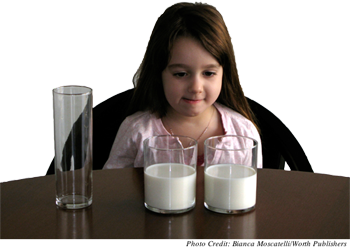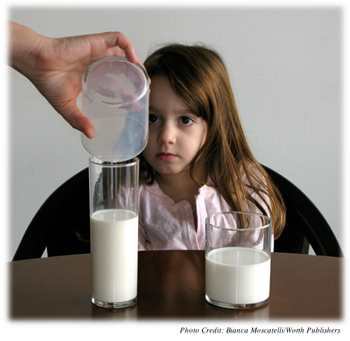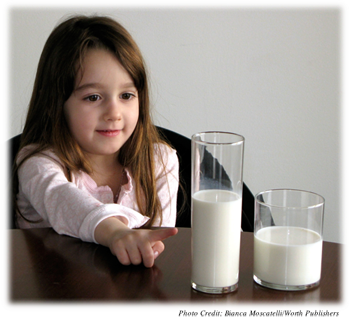

Chapter 1. Achieving Conservation
Synopsis
Achieving Conservation
Author

Thomas E. Ludwig, Hope College
Synopsis
This activity focuses on the changes in thinking that make it possible for older children to pass the Piagetian conservation of liquid task. You will watch video clips of older and younger children performing this conservation task and explaining their reasoning.
REFERENCES
Aredolo, C. (1982). Conservation-nonconservation: Alternative explanations. In C. J. Brainerd (Ed.), Children’s logical and mathematical cognition: Progress in cognitive development research. New York: Springer-Verlag, 1–31.
Anderson, D. R., & Clark, A. T. (1979). Recognition of correct justifications for conservation by conservers and partial conservers. Psychological Reports, 44, 1098.
Bruner, J. S. (1968). On the conservation of liquids. In J. S. Bruner, R. S. Olver, & P. M. Greenfield (Eds.), Studies in cognitive growth. New York: Wiley, 183–207.
Miller, P. H. (1973). Attention to stimulus dimensions in the conservation of liquid quantities. Child Development, 44, 129–136.
Piaget, J. (1971). The theory of stages in cognitive development. In D. Green, M. Ford, & G. Flamer (Eds.), Measurement and Piaget. New York: McGraw-Hill, 1–11.
Piaget, J. (2000). Piaget’s theory. In K. Lee (Ed.), Childhood cognitive development: The essential readings. Malden, MA: Blackwell, 33–47.
Siegler, R. S., & Liebert, R. M. (1972). Effects of presenting relevant rules and complete feedback on the conservation of liquid quantity task. Developmental Psychology, 7, 133–138.
Wadsworth, B. J. (1996). Piaget’s theory of cognitive and affective development (5th ed.). New York: Longman.
Understanding the Principle of Conservation

Jean Piaget, one of the most influential researchers in the study of cognitive development, believed that children’s thinking changes in important ways as they move from the preschool years into middle childhood. This transition from preoperational thought to concrete operational thought involves the development of what Piaget called mental operations, which are logical principles of reasoning.
Piaget’s most well-known task for measuring this transition is the liquid quantity problem. In this task, a child is shown two identical glasses, each with identical amounts of liquid in them. After the child agrees that the amount of liquid in the two glasses is equivalent, the researcher pours the liquid from one of the glasses into a tall, narrow glass. Because the level of the liquid in the tall glass is now higher than the liquid level in the original glass, most young children in the preoperational stage say that the tall glass has “more.”
Play the video to view the response of a typical preoperational child.
As you can see, young children fail to conserve the equivalence of the two amounts of liquid. They focus on the change in appearance, and they do not realize that the amount of liquid in the two different shaped glasses remains the same.
Achieving Conservation: Types of Reasoning

As children move into the concrete operational stage of thinking, they begin to realize that the transformation in the appearance of the liquid does not change the amount of liquid. In other words, they demonstrate an understanding of conservation.
What has changed in their thinking? Piaget believed that the child could correctly solve the liquid quantity problem by applying any one of three logical operations to the situation:
1. Identity: Since nothing has been added and nothing has been taken away, the amount must still be the same and identical to the amount in the original glass.
2. Reversibility: Although pouring the liquid into the tall, thin glass changes the appearance of the liquid, the child can imagine the liquid being poured back into the normal glass.
3. Reciprocity: The level of liquid is higher in the tall glass, but the glass is narrower. The increase in height is compensated by a reciprocal decrease in width so the amount must still be the same.
Play the video to observe the response of a concrete operational child. Can you determine which reasoning she is using?
Decentration

Piaget argued that the failure of a young child to demonstrate conservation could be explained as a problem of centration, the focusing on one dimension of the problem and the ignoring of the other dimensions. In this case, the young child centers or focuses on the height of the water in the glass and fails to consider the width of the glass.
Therefore, an older child who can pass this task and demonstrates an understanding of conservation is moving toward decentration. Piaget believed that decentration is an important part of cognitive development from middle childhood through adolescence as it allows children to gradually develop the mental operations that will enable them to take more and more aspects of the situation into account when solving a problem. Viewed in this way, decentration is good preparation for the complexities of adult life!
Assessment: Check Your Understanding

1.
Match the correct definition with each term. Click on an item in the left column, and then click the item in the right column that matches it.
conservation identity operation reversibility operation reciprocity operation centration decentrational problems | The liquid in the narrow glass is higher but it is also thinner. Taking more aspects of the situation into account when solving a problem. Nothing is added or taken away. Understanding that a transformation in appearance does not necessarily change the amount. Undoing the transformation would show that both the amounts are equal. Focusing on one dimension of the problem and ignoring the other dimensions. |
| Correct Matches: | |
Assessment: Check Your Understanding

2.
2. Piaget believed that school-age children have more knowledge than preschool children but that they both reason in pretty much the same way.
Assessment: Check Your Understanding

3.
3. In the context of Piaget’s conservation of liquid task, “conservation” means conserving or retaining the equivalence between the two quantities of water even when the appearance of the water changes.
Assessment: Check Your Understanding

4.
4. Preoperational children tend to fail this conservation of liquid task because they focus on the height of the water in the two glasses and ignore the width of the glasses.
Assessment: Check Your Understanding

5.
5. Play the video to watch seven-year-old Zoli discuss his reasoning on the conservation task. Which operation does he rely on in explaining the problem?
Assessment: Check Your Understanding

6.
6. Can you think of any common “real-life” situations in which an understanding of conservation would allow a concrete operational child to react differently than a preoperational child? Provide several examples in the space below.
Congratulations! You have completed this activity.Total Score: x out of x points (x%) You have received a provisional score for your essay answers, which have been submitted to your instructor.